Research on the Design of Coal Mine Microseismic Monitoring Network Based on Improved Particle Swarm Optimization
Abstract
:1. Introduction
2. Optimization Theory of the Microseismic Network
3. Impact Factors Analysis
3.1. The Microseismic Probability Factor
3.2. The Microseismic Importance Factor
3.3. The Effective Range Factor
4. Optimization of Microseismic Monitoring Network Design Based on Particle Swarm Optimization
4.1. Improved Particle Swarm Algorithm
4.2. Objective Function Construction
4.3. Evaluation Indicators of Network Design
4.4. Design Process of Microseismic Monitoring Network Based on IPSO
- (1)
- Module I: Station optimal scheme selection:
- ①
- According to the mining technical factors and geological factors related to the risk of rock burst on site, select the microseismic monitoring area, divide the structural area into a geographic grid, and determine the range of candidate points for the station.
- ②
- According to the on-site investigation or numerical analysis method, determine the microseismic probability factor Fe, the microseismic importance factor FQ, and the effective range factor FV to form a set of station candidate points.
- ③
- According to the D-value optimization theory, establish the station optimization objective function of Equation (9).
- ④
- Use the improved particle swarm algorithm (IPSO) proposed in this paper to select the optimal station scheme.
- (2)
- Module II: Station Scheme Evaluation:
- ①
- According to Equation (10), the sensitivity contour map and the positioning error map of the current network are calculated to preliminarily evaluate the feasibility of the network layout.
- ②
- Carry out the field test of percussion or blasting in the mine to obtain the positioning accuracy and stability of the current network layout scheme and further evaluate the pros and cons of the network layout.
- ③
- According to the above results, judge whether the performance of the station network can meet the needs of on-site microseismic monitoring.
5. Theory and Field Test Verification
5.1. Theoretical Experimental Research
5.2. Field Application Studies
5.2.1. Determination of Monitoring Area and Candidate Point Scheme
5.2.2. Solving the Optimal Solution
5.2.3. Evaluation of the Positioning Capability
- (1)
- Numerical simulation evaluation
- (2)
- Field test evaluation
6. Conclusions
- (1)
- With the D-value optimization design theory and the good global optimization ability of IPSO, the microseismic probability factor Fe, the microseismic importance factor FQ, and the effective range factor FV are introduced to establish the objective function of the optimal network layout scheme. The monitoring sensitivity and positioning error are used as evaluation criteria, and an optimization and evaluation system for the optimal layout of a mine’s microseismic network is proposed. The system consists of the station optimal scheme selection of Module I and the station scheme evaluation of Module II.
- (2)
- Using numerical simulation experiments, the improved particle swarm algorithm (IPSO) proposed provides a feasible method for the optimal design of the microseismic network. When there are a large number of candidate points, the method in this paper can quickly and cost-effectively complete the optimal network layout. In addition, the superiority of the optimal scheme is verified by the evaluation method.
- (3)
- Taking Xiashijie Coal Mine in Tongchuan, Shaanxi Province, as an example, IPSO took 244.86 s to optimize the arrangement of sensor candidate points in the key monitoring area of the mining area, according to the on-site geological conditions. The research results show that the algorithm can quickly find the optimal solution, the errors in key monitoring areas are all within 20 m, and the minimum monitoring magnitude is −3.26. The blasting test analysis shows that with the network layout scheme proposed in this study, the maximum error in the comprehensive location of the source is 12.2 m, and the average is 10.3 m. The positioning accuracy can meet the needs of engineering monitoring, and related research can provide a reference for the microseismic layout of similar projects.
Author Contributions
Funding
Institutional Review Board Statement
Informed Consent Statement
Data Availability Statement
Acknowledgments
Conflicts of Interest
References
- Xie, H.P.; Li, C.; He, Z.Q.; Li, C.B.; Lu, Y.Q.; Zhang, R.; Gao, M.Z.; Gao, F. Experimental study on rock mechanical behavior retaining the in situ geological conditions at different depths. Int. J. Rock Mech. Min. Sci. 2021, 138, 104548. [Google Scholar] [CrossRef]
- Feng, X.T.; Liu, J.P.; Chen, B.R.; Xiao, Y.X.; Feng, G.L.; Zhang, F.P. Monitoring, warning and control of rockburst in deep metal mines. Engineering 2017, 3, 538–545. [Google Scholar] [CrossRef]
- Chen, F.; Wang, X.B.; Du, Y.H.; Tang, C.A. Numerical experiment research on failure characteristics of anchored rock with negative Poisson’s ratio bolt. Front. Earth Sci. 2022, 10, 899755. [Google Scholar] [CrossRef]
- Mngadi, S.B.; Durrheim, R.J.; Manzi, M.S.D.; Ogasawara, H.; Yabe, Y.; Yilmaz, H.; Wechsler, N.; Van Aswegen, G.; Roberts, D.; Ward, A.K.; et al. Integration of underground mapping, petrology, and high-resolution microseismicity analysis to characterise weak geotechnical zones in deep South African gold mines. Int. J. Rock Mech. Min. Sci. 2019, 114, 79–91. [Google Scholar] [CrossRef]
- Cheng, G.W.; Li, L.C.; Zhu, W.C.; Yang, T.H.; Tang, C.A.; Zheng, Y.; Wang, Y. Microseismic investigation of mining induced brittle fault activation in a Chinese coal mine. Int. J. Rock Mech. Min. Sci. 2019, 123, 104096. [Google Scholar] [CrossRef]
- Chen, F.B. Influence of mine microseism location sub network distribution to positioning precision. Coal Min. Technol. 2016, 21, 107–114. [Google Scholar]
- Zhao, Y.P.; Gao, J.C.; Liu, L.; Mao, G.L.; Chang, L.; Ji, A.D.; Wang, S.X.; Zhao, M.C. Research on the influence of positioning sub-station network selection on positioning results. Earthquake 2006, 26, 37–44. [Google Scholar]
- Mou, Z.L.; Dou, L.M.; Gong, S.Y.; Cao, A.Y. Networking design of SOS micro-seismic monitoring for mine and error analysis of seismic resource orientation. Coal Min. Technol. 2009, 14, 8–12. [Google Scholar]
- Kijko, A. An algorithm for optimum distribution of a regional seismic network-I. Pure Appl. Geophys. 1977, 115, 999–1009. [Google Scholar] [CrossRef]
- Kijko, A. An algorithm for optimum distribution of a regional seismic network-II. An analysis of the accuracy of location of local earthquakes depending on number of seismic stations. Pure Appl. Geophys. 1977, 115, 1011–1021. [Google Scholar] [CrossRef]
- Mendecki, A.J. Seismic Monitoring in Mines, 1st ed.; Chapman and Hall Press: London, UK, 1997; pp. 100–107. [Google Scholar]
- Andrzej, L. Seismic network configuration by reduction of seismic source location errors. Int. J. Rock Mech. Min. Sci. 2015, 80, 118–128. [Google Scholar]
- Zhang, Z.Y.; Arosio, D.; Hojat, D.; Zanzi, L. Designing the expanded microseismic monitoring network for an unstable rock face in Northern Italy. Pure Appl. Geophys. 2022, 179, 1623–1644. [Google Scholar] [CrossRef]
- Tang, L.Z.; Yang, C.X.; Pan, C.L. Optimization of microseismic monitoring network for large-scale deep well mining. Chin. J. Rock Mech. Eng. 2006, 10, 2036–2042. [Google Scholar]
- Gong, S.Y.; Dou, L.M.; Cao, A.Y.; He, H.; Du, H.T. Study on optimal configuration of seismological observation network for coal mine. Chin. J. Geophys. 2010, 53, 457–465. [Google Scholar]
- Gong, S.Y.; Dou, L.M.; Ma, X.P.; Mou, Z.L.; Lu, C.P. Optimization algorithm of network configuration for improving location accuracy of microseism in coal mine. Chin. J. Rock Mech. Eng. 2012, 31, 8–17. [Google Scholar]
- Gao, Y.T.; Wu, Q.L.; Wu, S.C.; Ji, M.W.; Cheng, A.P.; Yang, K. Optimization of microseismic monitoring networks based on the theory of d-optimal design. Beijing Keji Daxue Xuebao Yingweban 2013, 35, 1538–1545. [Google Scholar]
- Cui, Y.; Li, X.B.; Dong, L.J.; Bai, L. Optimization of micro-seismic monitoring network layout in Linglong gold mine. Gold Sci. Technol. 2019, 27, 417–424. [Google Scholar]
- Li, H.B.; Wang, S.F.; Chen, Q.; Gong, M.G.; Chen, L.W. IPSMT: Multi-objective optimization of multipath transmission strategy based on improved immune particle swarm algorithm in wireless sensor networks. Appl. Soft. Comput. 2022, 121, 108705. [Google Scholar] [CrossRef]
- Wang, N.; Liu, J.F.; Lu, J.; Zeng, X.Y.; Zhao, X.Y. Low-delay layout planning based on improved particle swarm optimization algorithm in 5G optical fronthaul network. Opt. Fiber Technol. 2021, 67, 102736. [Google Scholar] [CrossRef]
- Su, Z.Y.; Xu, F.X.; Hua, L.; Chen, H.; Wu, K.Y.; Zhang, S. Design optimization of minivan MacPherson-strut suspension system based on weighting combination method and neighborhood cultivation genetic algorithm. Proc. Inst. Mech. Eng. Part D–J Automob. Eng. 2018, 233, 650–660. [Google Scholar] [CrossRef]
- Liu, T.J.; Song, H.Q.; Zhang, J.; Luo, X.T.; Peng, R.Y.; Zhang, X.Y. Application of the fuzzy analytic hierarchy process in deep space exploration program optimization in China. Chin. J. Eng. 2022, 44, 1433–1443. [Google Scholar]
- Shen, Y.Z.; Chen, Y.; Hao, Z.H.; Liu, D.; Li, G.Q. Evaluation and optimization of uranium mining scheme based on genetic algorithm. Uranium Min. Metall. 2021, 40, 6–12, 24. [Google Scholar]
- Steinberg, D.M.; Rabinowitz, N. Optimal seismic monitoring for event location with application to on site inspection of the comprehensive nuclear test ban treaty. Metrika 2003, 58, 31–57. [Google Scholar] [CrossRef]
- Xia, Y.X.; Kang, L.J.; Qi, Q.X.; Mao, D.B.; Ren, Y.; Lan, H.; Pan, J.F. Five indexes of microseismic and their application in rock burst forecastion. J. Chin. Coal Soc. 2010, 35, 2011–2016. [Google Scholar]
- Kennedy, J.; Eber-hart, R. Particle swarm optimization. In Proceedings of the IEEE International Conference on Neural Networks, Perth, Australia, 27 November–1 December 1995. [Google Scholar]
- Isiet, M.; Gadala, M. Self-adapting control parameters in particle swarm optimization. Appl. Soft. Comput. 2019, 83, 105653. [Google Scholar] [CrossRef] [Green Version]
- Wu, K.; Sheng, Q.; Mei, S.H.; Li, J. A model of PSO-LSSVM and its application to displacement back analysis. Rock Soil Mech. 2009, 30, 1109–1114. [Google Scholar]
- Sahib, M.A.; Abdulnabi, A.R.; Mohammed, M.A. Improving bacterial foraging algorithm using nonuniform elimination-dispersal probability distribution. Alex. Eng. J. 2018, 57, 3341–3349. [Google Scholar] [CrossRef]
- Wang, K.K.; Tang, C.A.; Ma, K.; Yu, G.F.; Zhang, S.C.; Peng, Y.L. Cross-related microseismic location based on improved particle swarm optimization and the double difference location method of jointed coal rock mass. Waves Random Complex Media 2021, 2009151. [Google Scholar] [CrossRef]
- Kijko, A.; Sciocatti, M. Optimal spatial distribution of seismic stations in mines. Int. J. Rock Mech. Min. Sci. 1995, 32, 607–615. [Google Scholar] [CrossRef]
- Tang, L.Z. Study on Monitoring and Prediction of Seismicity and Rockburst in a Deep Mine. Ph.D. Thesis, Central South University, Changsha, China, 6 June 2008. [Google Scholar]
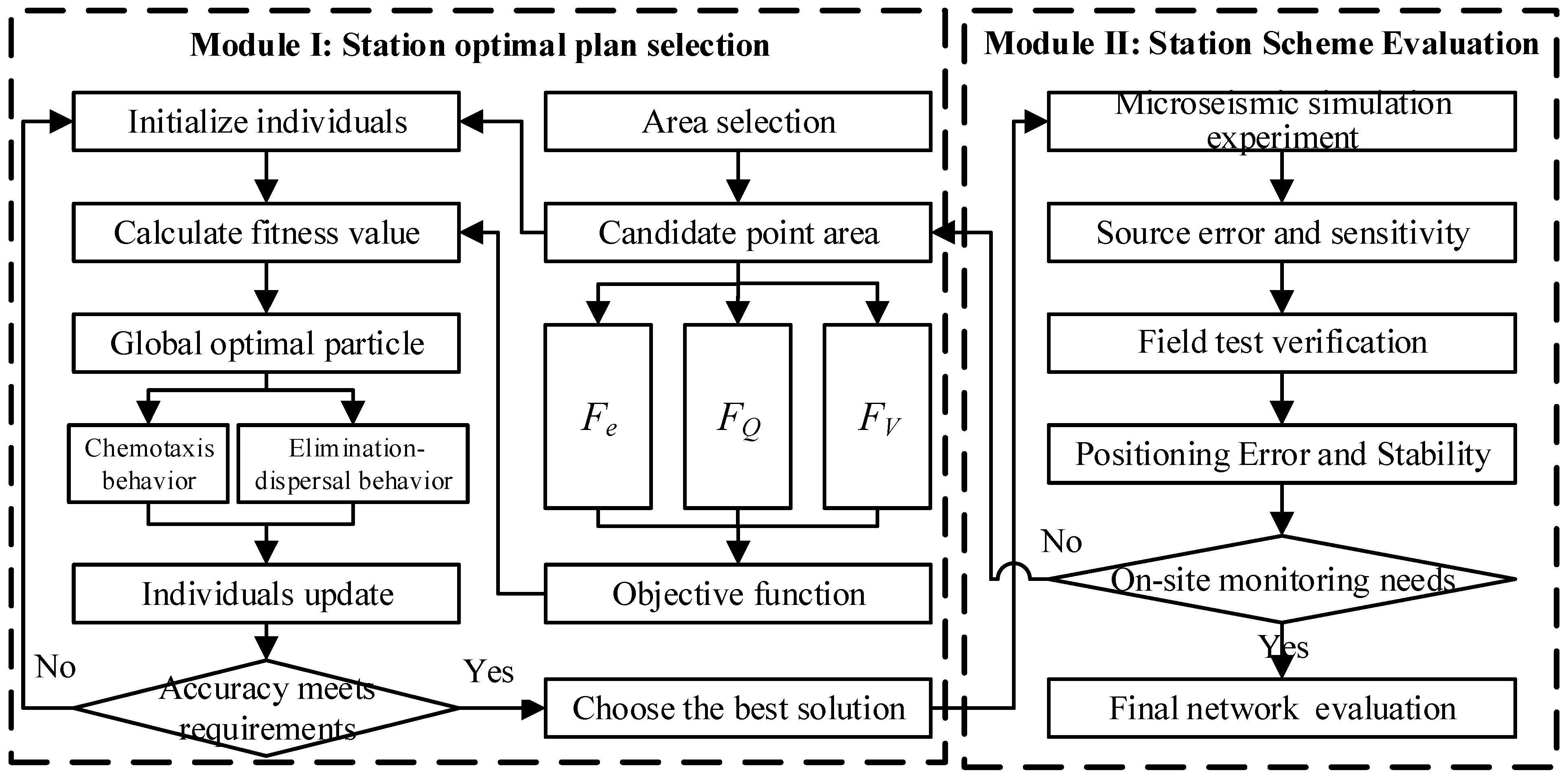
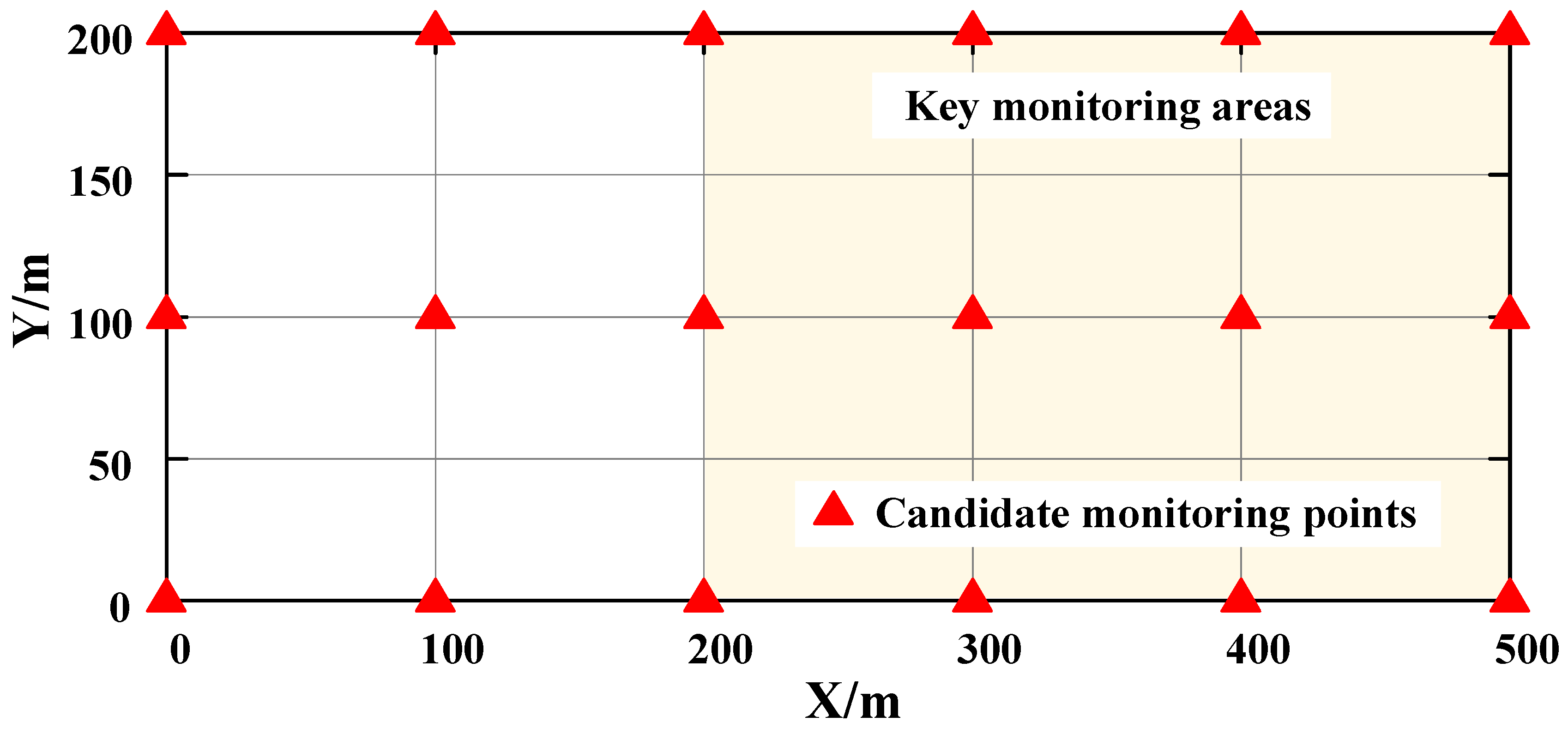

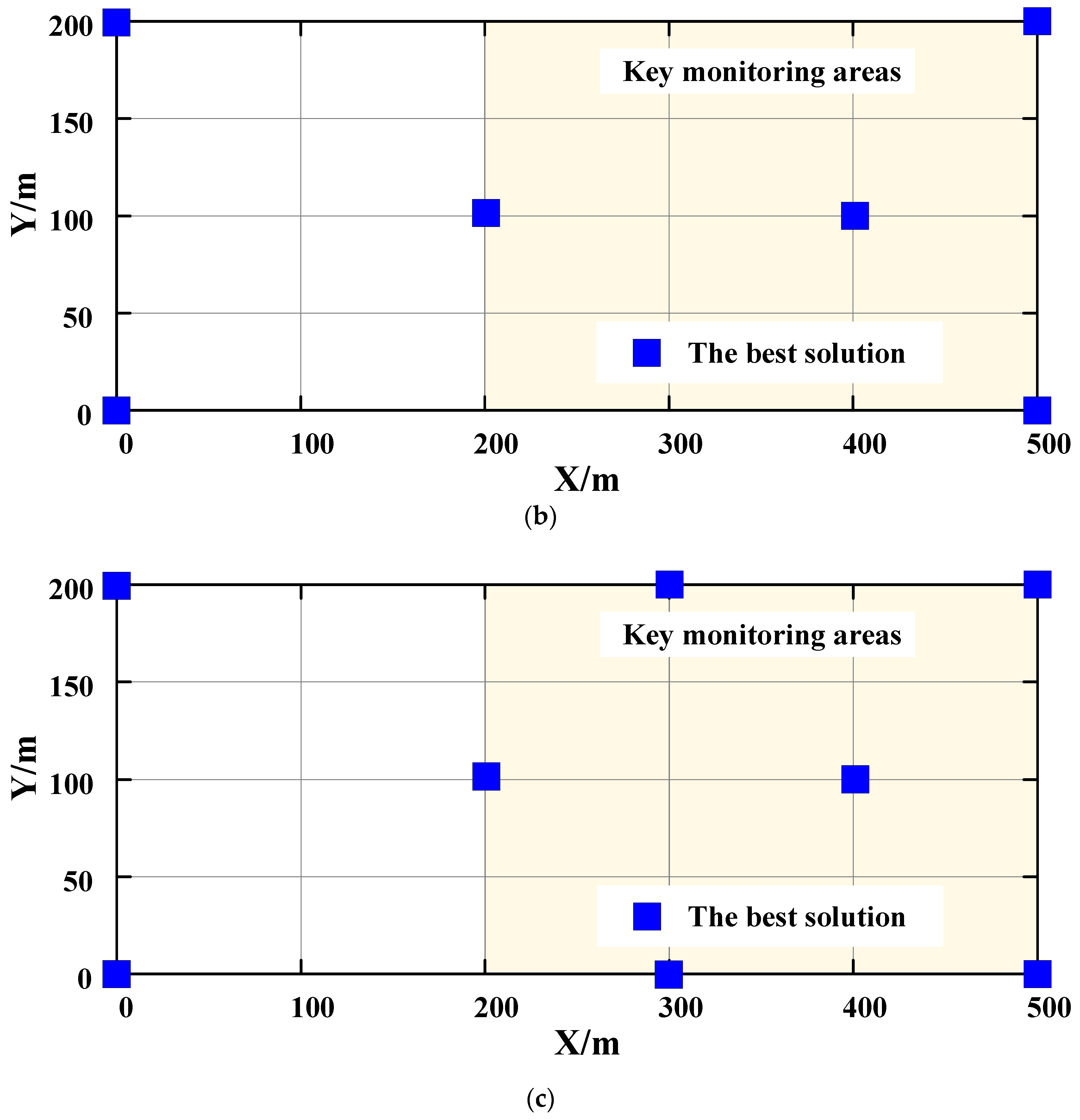
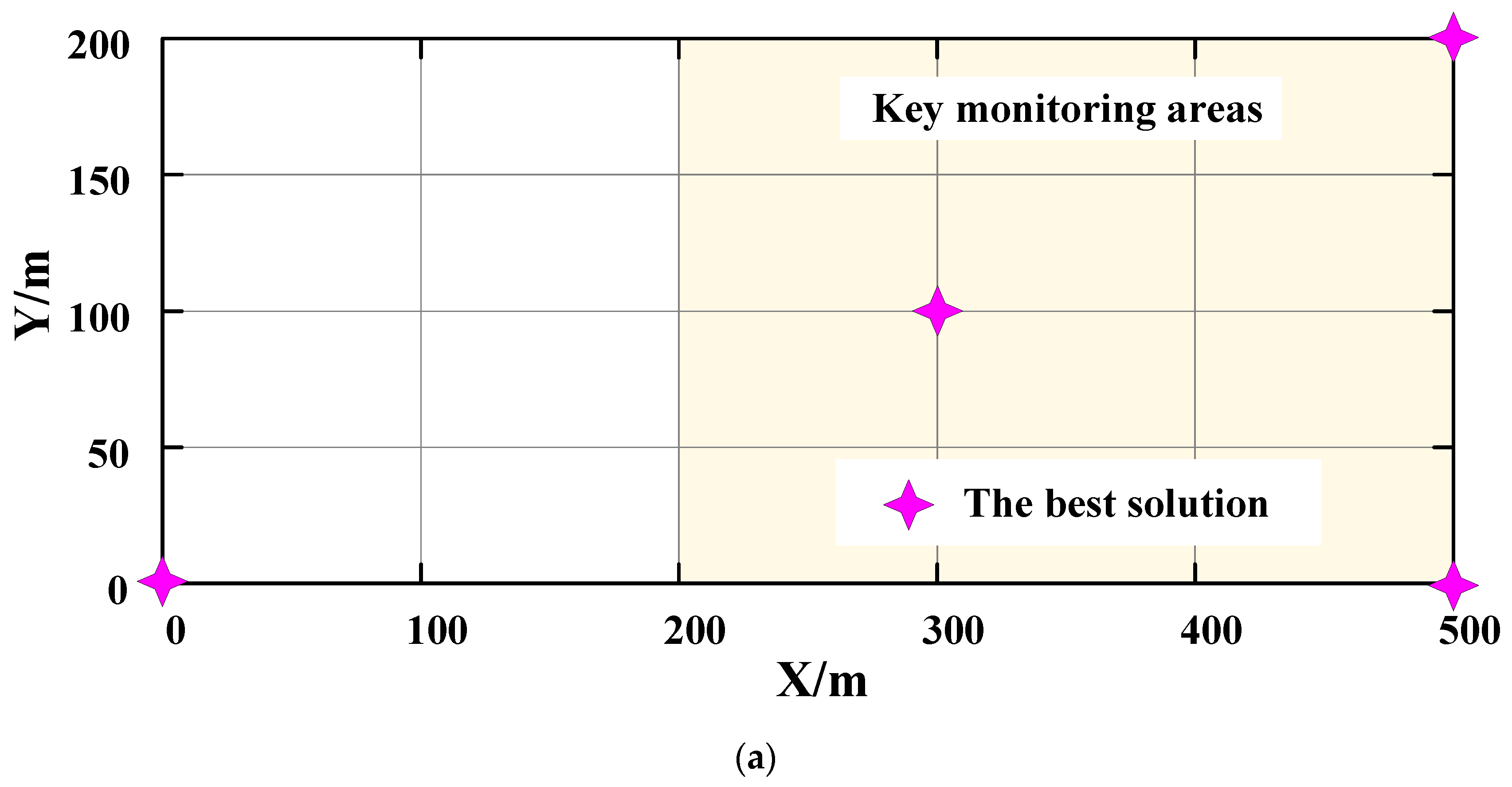
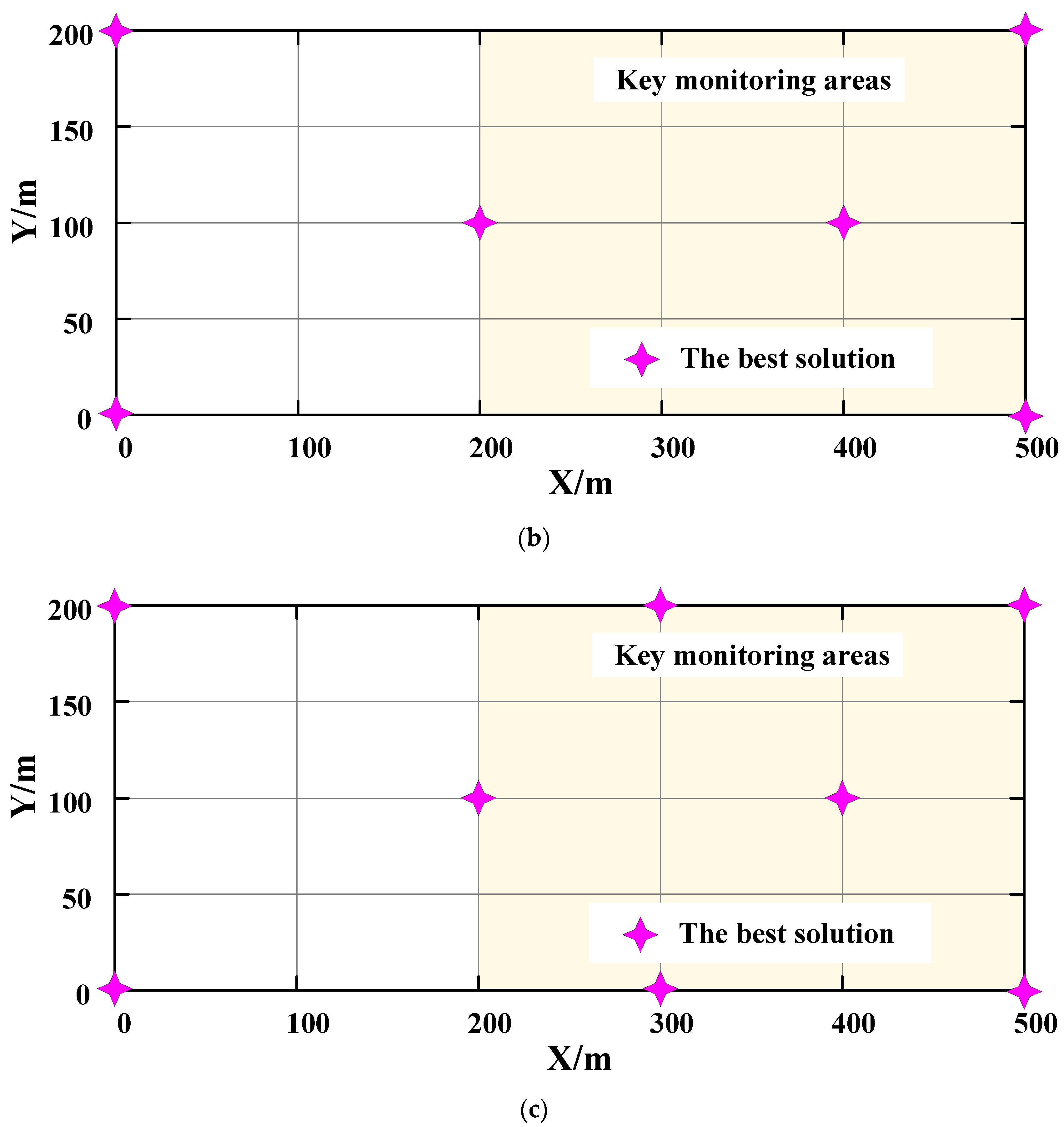


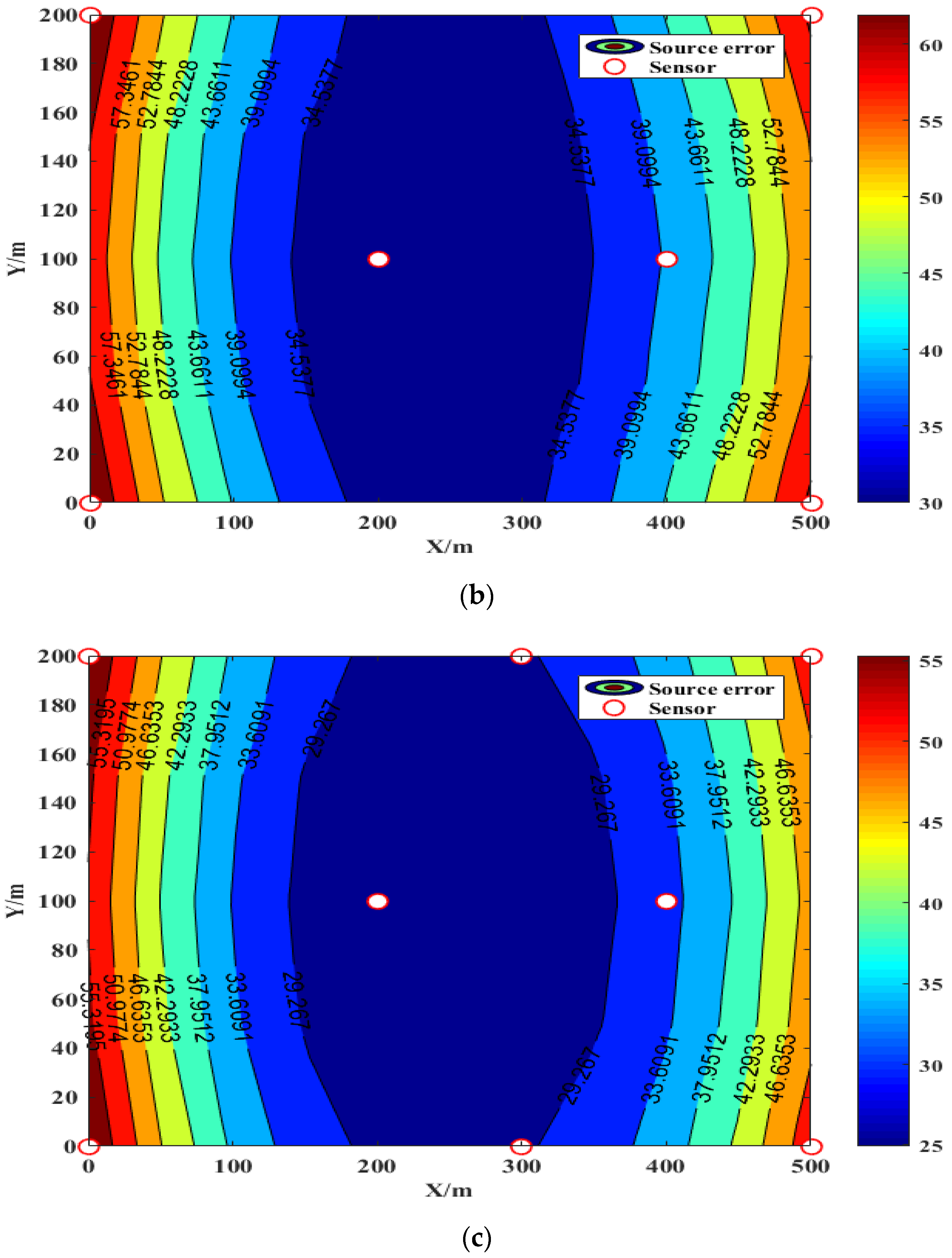
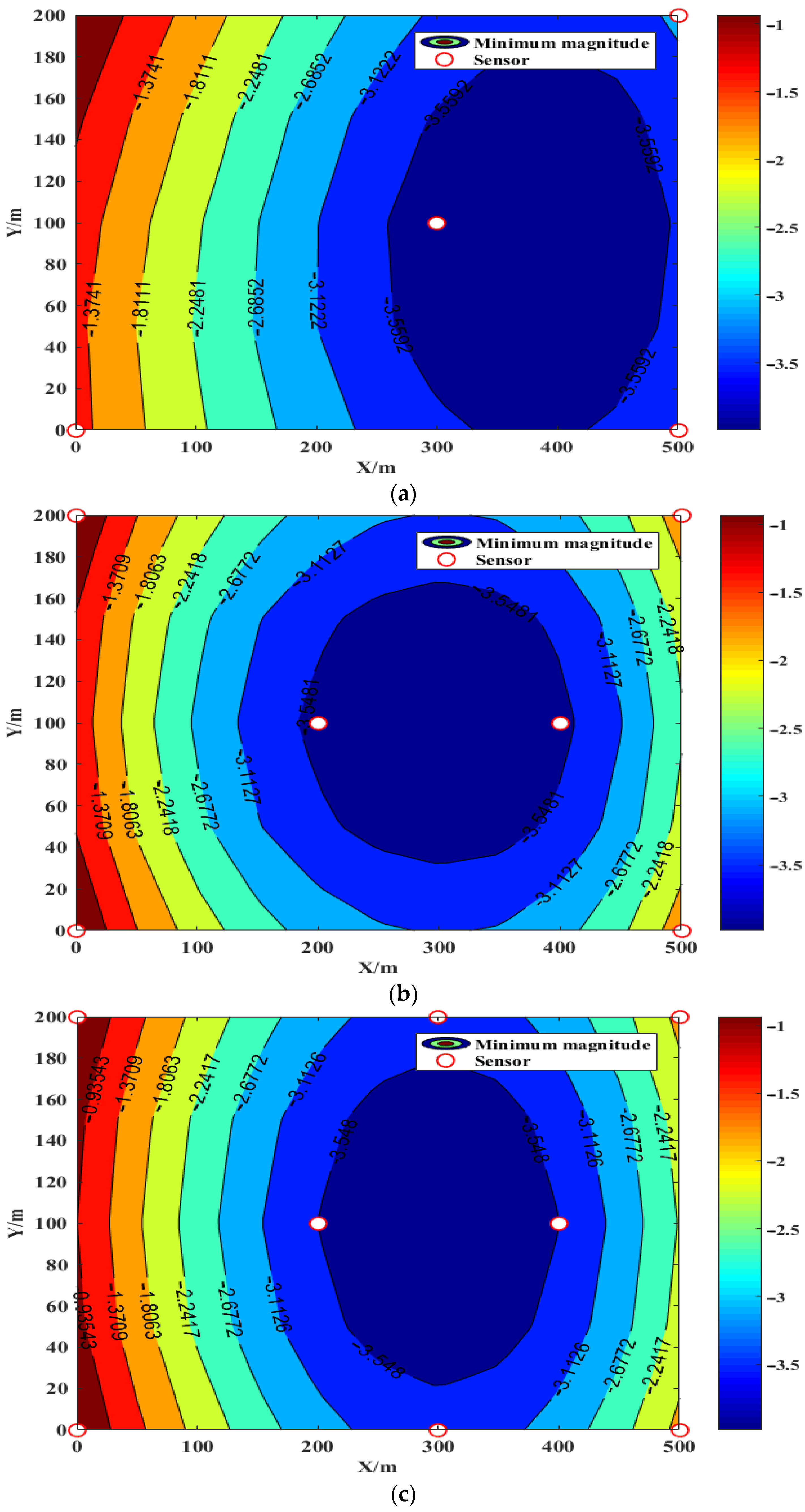
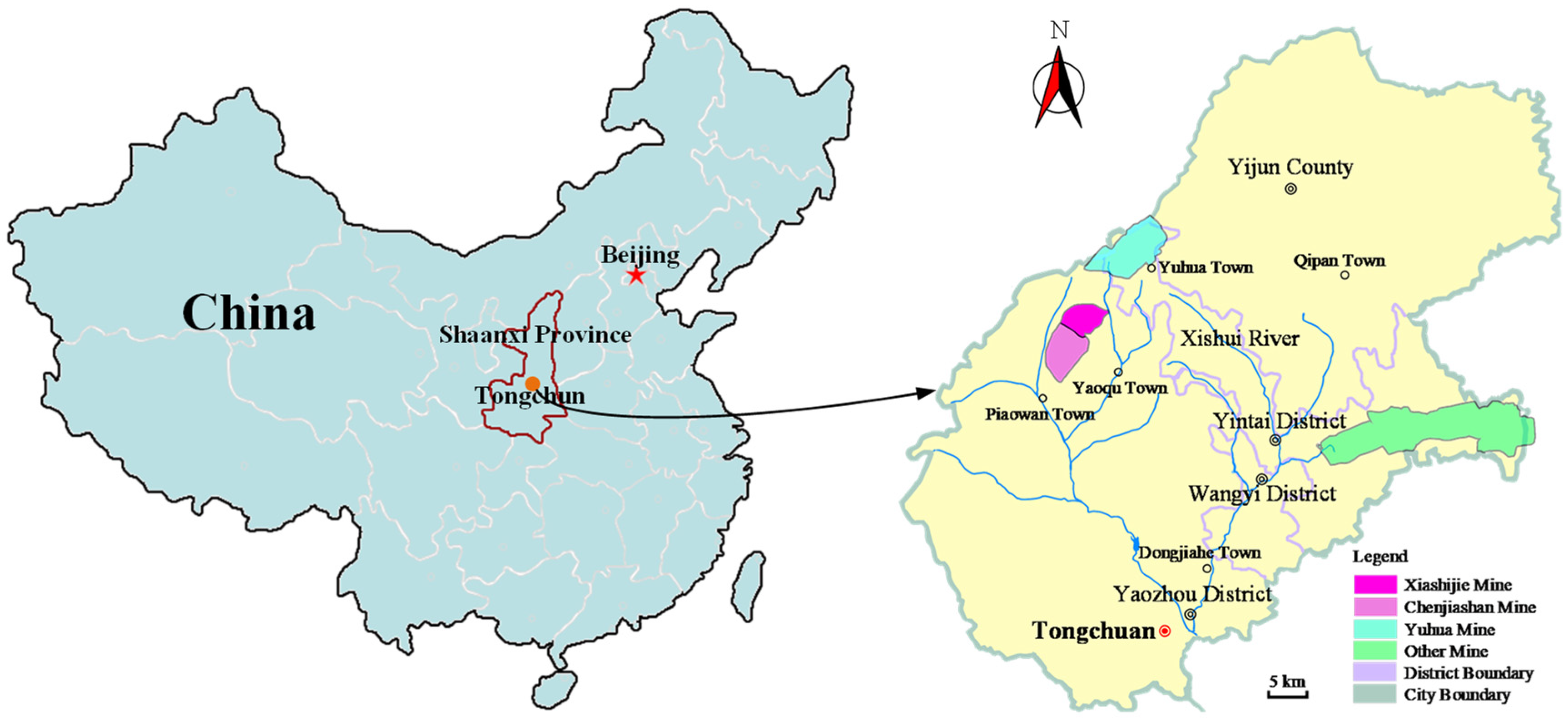

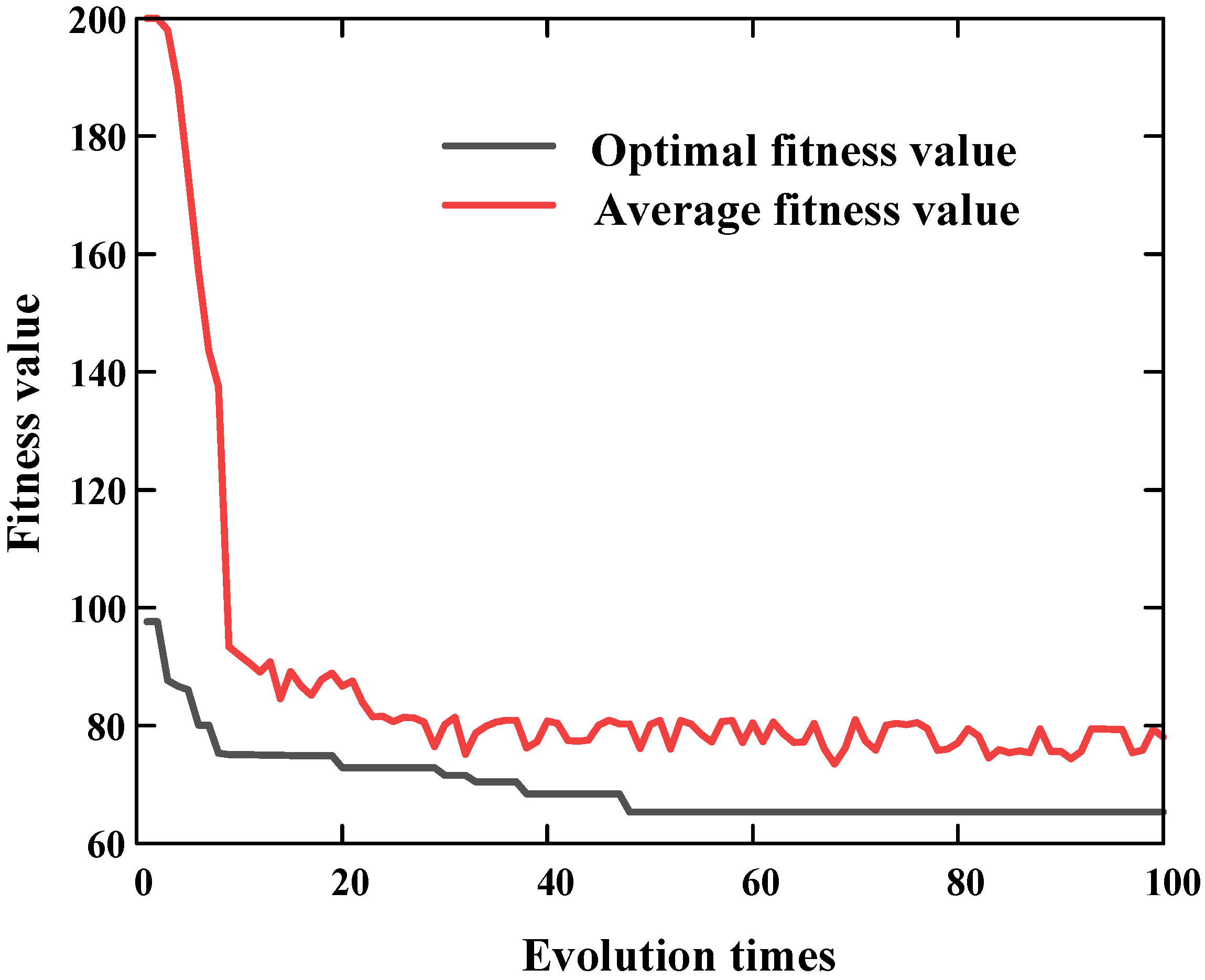


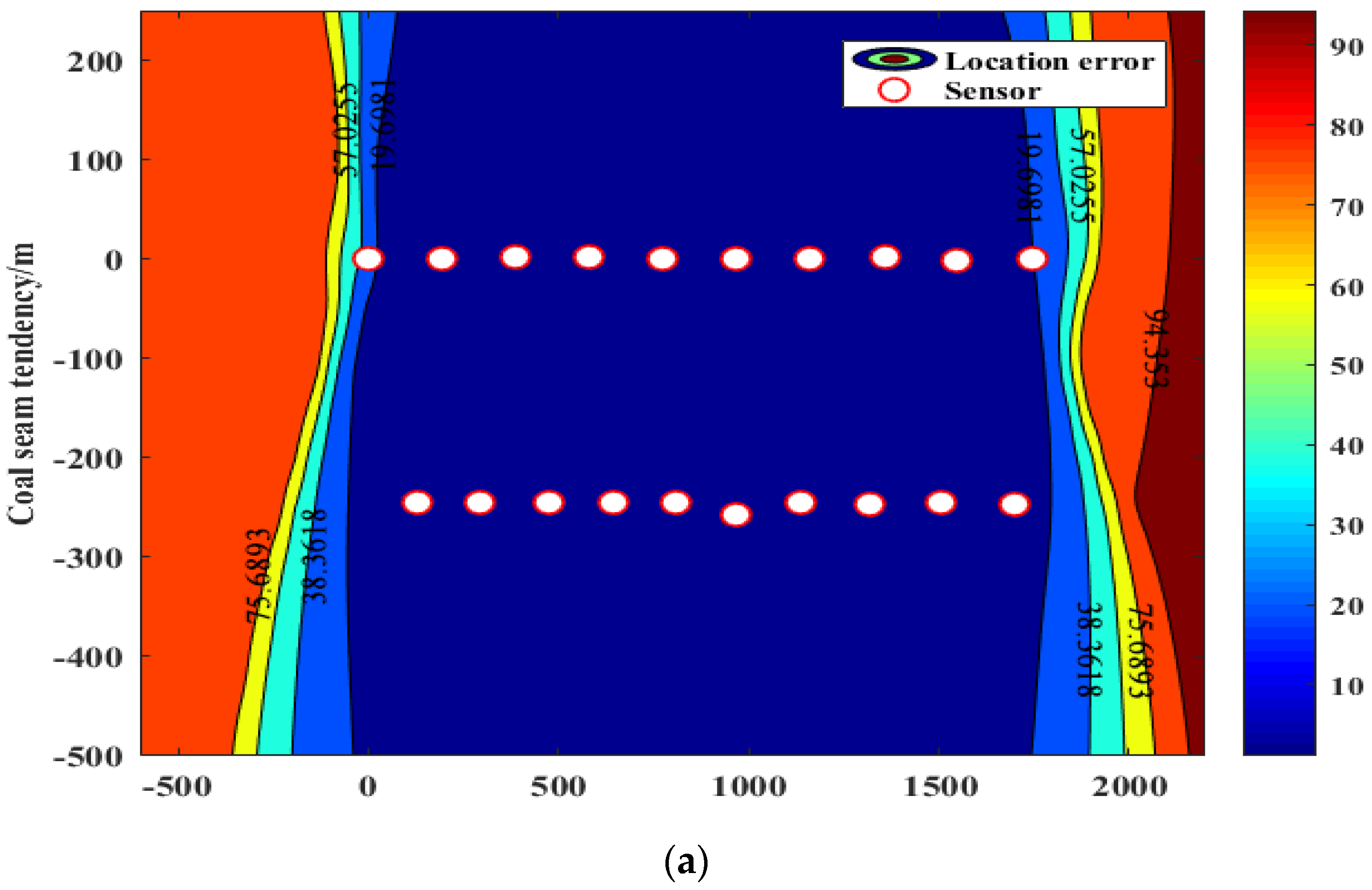

| Monitoring Area | Key Areas | Sub-Key Areas | Normal Areas |
|---|---|---|---|
| the effective range factor FQ | 1.5 | 1.2 | 1.0 |
| Schemes | Monitoring Points | Sensors | Combinations | Results |
|---|---|---|---|---|
| Scheme I | 18 | 4 | 3060 | Figure 3a |
| Scheme II | 18 | 6 | 18564 | Figure 3b |
| Scheme III | 18 | 8 | 43758 | Figure 3c |
| Schemes | Running time | Solutions | |||
|---|---|---|---|---|---|
| EA | SA | IPSO | EA | EA and IPSO | |
| Scheme I | 48.01 | 17.74 | 15.63 | Figure 3a | Figure 4a |
| Scheme II | 144.32 | 26.65 | 22.55 | Figure 3b | Figure 4b |
| Scheme III | 261.88 | 37.4 | 27.06 | Figure 3c | Figure 4c |
| Serial Number | Blasting Coordinates | Positioning Coordinates | ||||
|---|---|---|---|---|---|---|
| x/m | y/m | z/m | x/m | y/m | z/m | |
| 1 | 2710.5 | 3647.4 | 935.5 | 2709 | 3640 | 938.1 |
| 2 | 2220.6 | 3302.8 | 938.7 | 2215 | 3310 | 933.4 |
| 3 | 2065.9 | 3201.3 | 925.8 | 2061 | 3210 | 932.9 |
| Serial Number | Time | Errors | Absolute Error/m | ||
|---|---|---|---|---|---|
| x/m | y/m | z/m | |||
| 1 | 15:35 | 1.5 | 7.4 | 2.6 | 8 |
| 2 | 15:54 | 5.6 | 7.2 | 5.3 | 10.6 |
| 3 | 17:55 | 4.9 | 8.7 | 7.1 | 12.2 |
| Max | - | 5.6 | 8.7 | 7.1 | 12.2 |
| Mean | - | 4.0 | 7.8 | 5.0 | 10.3 |
Publisher’s Note: MDPI stays neutral with regard to jurisdictional claims in published maps and institutional affiliations. |
© 2022 by the authors. Licensee MDPI, Basel, Switzerland. This article is an open access article distributed under the terms and conditions of the Creative Commons Attribution (CC BY) license (https://creativecommons.org/licenses/by/4.0/).
Share and Cite
Wang, K.; Tang, C.; Ma, K.; Ma, T. Research on the Design of Coal Mine Microseismic Monitoring Network Based on Improved Particle Swarm Optimization. Appl. Sci. 2022, 12, 8439. https://doi.org/10.3390/app12178439
Wang K, Tang C, Ma K, Ma T. Research on the Design of Coal Mine Microseismic Monitoring Network Based on Improved Particle Swarm Optimization. Applied Sciences. 2022; 12(17):8439. https://doi.org/10.3390/app12178439
Chicago/Turabian StyleWang, Kaikai, Chun’an Tang, Ke Ma, and Tianhui Ma. 2022. "Research on the Design of Coal Mine Microseismic Monitoring Network Based on Improved Particle Swarm Optimization" Applied Sciences 12, no. 17: 8439. https://doi.org/10.3390/app12178439
APA StyleWang, K., Tang, C., Ma, K., & Ma, T. (2022). Research on the Design of Coal Mine Microseismic Monitoring Network Based on Improved Particle Swarm Optimization. Applied Sciences, 12(17), 8439. https://doi.org/10.3390/app12178439








